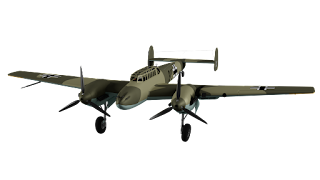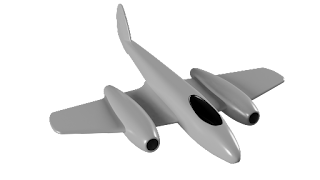New updates for: Bf 110C-7, G.55 Centauro and Gloster Meteor (new project) - July 30, 2023
Hello everyone. It's me Antony, back with another blog in 2023. I know. Now that I'm working and studying, my time for Blogs decreased to some occasions. At least it is good to be back at work.
A while ago, the town hall announced a new civil service exam for this year - with some to the education and health departments. I may give it a shot, but it will be the same thing as before - Reserve my rest days for study. If I fail, it would be another civil service performed, with my money being spent for nothing.
For the calling process to work as a teacher, probably I'm going to give it up due to the lack / low numbers of vacancies for mathematics teachers.
Enough of that, let's go for the important. For this Blog, I'm going to show you the new renders of the Messerschmitt Bf 110 C-7 and the Fiat G.55 Centauro.
Messerschmitt Bf 110 C-7:
The Bf 110 received some adjustments on its texture. The yellow painting layers are now part of the texture instead of being separate materials. Another change was the smoke from the engine outlets. I added it along the smoke from its main armament. At least this German heavy fighter is looking good.
I plan to add a new Armature to rig it and the cockpit components like the pilot and gunner seats, the instrument panel and the stick. For the night fighter version, I have the FuG 220 Lichtenstein SN-2 radar antennas ready - with the engine superchargers and the Schräge Musik machine guns as the next components to make.
Fiat G.55 Centauro:
I decided to rig the G.55 after making some small components (the air intakes on the engine cowling, the reflective gunsights and the instrument panel). Fortunately most of the actions made for the Macchi C.202 and C.205 can be adapted to the G.55 - with some minor changes in the animation due to the additional bones in relation to my previous Italian planes.
Unless I plan to make a different texture for this aircraft and add more components like the seat and the stick, this G.55 Centauro is looking great. Probably I plan to preserve this temporary material / texture.
Before concluding this Blog, one last thing. Again, my habit of starting new projects while I have 'thousands' of undergoing projects to conclude is quite interesting. For the new project, I decided to start the British Gloster Meteor. My brother asked me when I plan to make the Horten Ho 229 - the famous German flying wing that inspired in the development of the Stealth planes like the B-2 Spirit and the F-117 Nighthawk. I plan to make the Horten, although it didn't advanced as a prototype before its capture by the Americans and some of its parts remain in the Smithsonian National Air and Space Museum.
The British Gloster Meteor is the first operational jet fighter produced in WW2 to the initial days of the Cold War. The development of the turbojet-powered Gloster Meteor was a collaboration between the Gloster Aircraft Company and Frank Whittle's firm, Power Jets Ltd. Whittle formed Power Jets Ltd in March 1936 to develop his ideas of jet propulsion, Whittle himself serving as the company's chief engineer. For several years, attracting financial backers and aviation firms prepared to take on Whittle's radical ideas was difficult; in 1931, Armstrong-Siddeley had evaluated and rejected Whittle's proposal, finding it to be technically sound but at the limits of engineering capability. Securing funding was a persistently worrying issue throughout the early development of the engine. The first Whittle prototype jet engine, the Power Jets WU, began running trials in early 1937; shortly afterwards, both Sir Henry Tizard, chairman of the Aeronautical Research Committee, and the Air Ministry gave the project their support. In August 1940, Carter presented Gloster's initial proposals for a twin-engined jet fighter with a tricycle undercarriage. On 7 February 1941, Gloster received an order for twelve prototypes (later reduced to eight) under Specification F9/40. It would be initially named Thunderbolt, however, to avoid confusion with the American Republic P-47 Thunderbolt which had been issued with the same name to the RAF in 1944, the aircraft's name was subsequently changed to Meteor. During WW2, No. 616 Squadron RAF was the first to receive operational Meteors: a total of 14 aircraft were initially delivered. The conversion to the Meteor was initially a matter of great secrecy. Following a conversion course at Farnborough attended by the squadron's six leading pilots, the first aircraft was delivered to Culmhead on 12 July 1944. The squadron and its seven Meteors moved on 21 July 1944 to RAF Manston on the east Kent coast and, within a week, 32 pilots had been converted to the type. The Meteor was initially used to counter the V-1 flying bomb threat. 616 Squadron Meteors saw action for the first time on 27 July 1944, when three aircraft were active over Kent. These were the first operational jet combat missions for the Meteor and for the Royal Air Force. After some problems, especially with jamming guns, the first two V1 "kills" were made on August 4th. By war's end, Meteors had accounted for 14 flying bombs. After the end of the V-1 threat, and the introduction of the ballistic V-2 rocket, the RAF was forbidden to fly the Meteor on combat missions over German-held territory for fear of an aircraft being shot down and salvaged by the Germans. Although many pilots hoped to confront the Messerschmitt Me 262, no aerial combat was engaged between the two jet fighters. By the end of the war, the Meteors had destroyed 46 German aircraft during ground attacks. After WW2, the Meteors maintained the vanguard as jet fighters along the De Havilland Vampire until the arrival of modern jet fighters like the North American F-86 Sabre and the MiG 15. In the Korean War, Meteors flown by the Australian Air Force faced Soviet MiG 15s, despite the losses for British planes and pilots. With the introduction of the Supermarine Swift, Hawker Hunter and Gloster Javelin, the Meteor was retired from the RAF in the 1950s with several units being sold to other nations like Argentina, Israel, Australia, Egypt, Syria, France and Brazil. The Meteors were the first jet fighters to equip the Brazilian Air Force, with 60 new Meteor F.8s and 10 T.7 trainers being shipped in October 1952. As the economic conditions were fragile after the war, the only commodity available was 15,000 tons of raw cotton. Brazil operated the Meteors until 1970 where the new jet planes were acquired from the Americans, French and Italians.
Here's the images of the Meteor. The model selected is the Mk IV / F.4:
The Meteor's first components were the fuselage, the engine, the wings and the tail fin + rudder. The tail fin was a little tricky to make since the rudder consisted in two parts and the fixed component would be the base for the horizontal tail.
On the fuselage, I decided to extract a small piece to make the tricycle landing gear fairing.
After these renders, I made more components for the Gloster Meteor.
Similar to the Messerschmitt Me 262, I made a small component to represent the hot air coming out from the engine. In addition, I added the ports for the Hispano cannons, the canopy framing and glass, the Pitot tube, the horizontal tail + elevator, the antennas and the decals.
For one thing, I think I can conclude the Meteor pretty soon. However, due to my time being reserved to job, then to my studies for the next semester in the University, and my previous projects that needs to be finished, the Meteor will be made at some moments, unless I plan to give it top priority.
Aside from the RAF roundels, I added the Brazilian markings to this plane, although I'll share its images in the future.
For the next components, I'll make the flaps, the ailerons, the landing gear and the cockpit instruments.
Well, that's it for now my friends. I hope you like this Blog. In case I have some spare time to enjoy, I'll be working on other things aside from Blender projects and my personal things. Until the time comes, you will be surprised to see them. See you next time.
My DeviantArt:
My second Youtube channel:
My other Blogspot places:
My Facebook page:
My Instagram:
My ArtStation:
Note: Don't you dare to download these images and re-share it without my permission. If you do, please, leave the original author name.





































Comments
Post a Comment